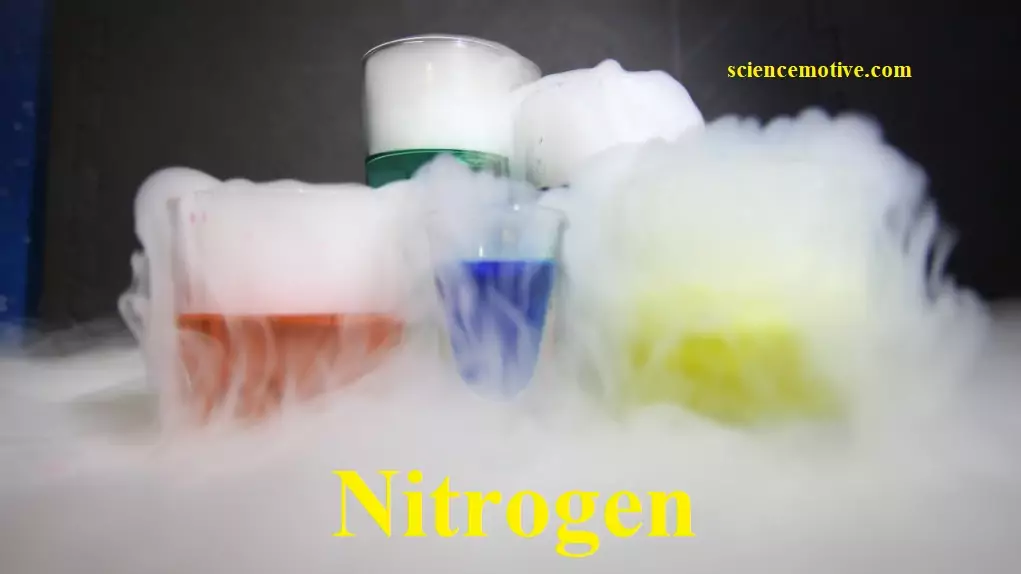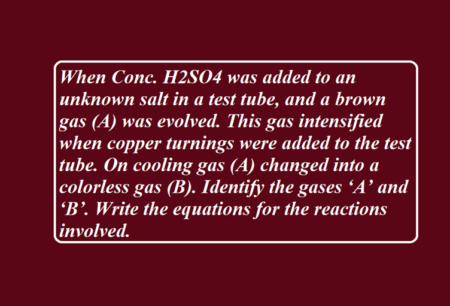Compounds and Properties of Nitrogen
Dinitrogen
Preparation of Dinitrogen: Dinitrogen is produced commercially by the liquefaction and fractional distillation of air. In the laboratory, dinitrogen is prepared by treating an aqueous solution of ammonium chloride with sodium nitrite.
NH4CI(aq) + NaNO2(aq) → N2(g) + 2H2O(l) + NaCl (aq)
It can also be obtained by the thermal decomposition of ammonium dichromate (NH4)2Cr2O7 →Heat N2 + 4H2O + Cr2O3
Very pure nitrogen can be obtained by the thermal decomposition of sodium or barium azide.
Ba(N3)2 → Ba + 3N2
Properties of Dinitrogen:
(i) Dinitrogen is inert at room temperature because of the high bond enthalpy of N≡N bond.
(ii) At higher temperatures, it directly combines with some metals to form ionic nitrides and with non-metals to form covalent nitrides.
(iii) N2 is a colourless, odourless gas insoluble in water.
(iv) It is neither combustible nor a supporter of combustion.
(v) 6Li + N2 →Heat 2Li3N; 3Mg + N2 →Heat Mg3N2
(vi) It combines with hydrogen at about 773 K in the presence of a catalyst Fe (Haber’s Process) to form ammonia: N2 +3H2 → 2NH3
(vii) Dinitrogen combines with dioxygen at very high temperature (at about 2000 K) to form nitric oxide N2 + O2 → 2 NO
Uses of Dinitrogen:
(i) The main use of dinitrogen is in the manufacture of ammonia and other industrial chemicals containing nitrogen (e.g., calcium cyanamide).
(ii) It also used to create an inert atmosphere in metallurgy.
(iii) Liquid dinitrogen is used as a refrigerant to preserve biological materials, food items and in cryosurgery.
Compounds and Properties of Nitrogen
Ammonia
Preparation: In the laboratory, ammonia is obtained by treating ammonium salts with caustic soda (NaOH) or slaked lime.
(NH4)2SO4 + 2NaOH → 2NH3 + 2H2O + Na2SO4
2NH4Cl + Ca(OH)2 → 2NH3 + 2H2O + CaCl2
On a large scale, ammonia is manufactured by Haber’s process.
N2(g) + 3H2(g) → 2NH3(g)
In accordance with Le Chatelier’s principle, high pressure of about 200 atm, a temperature of about 773 K and a catalyst such as iron oxide with small amounts of K2O and Al2O3 are employed to increase the rate of this reaction.
Properties of Ammonia:
(i) Ammonia is a colourless gas with a pungent smell.
(ii) It is highly soluble in water because of its ability to form an intermolecular hydrogen bond with water.
(iii) Liquid ammonia has high melting and boiling points because of intermolecular hydrogen bonding.
(iv) The ammonia molecule has a trigonal pyramidal geometry. It has three bond pairs and one lone pair of electrons. 
(v) Its aqueous solution is weakly basic due to the formation of OH– ions.
NH3(g) + H2O(l) → NH4+ (aq) + OH– (aq)
(vi) As a weak base, it precipitates the hydroxides of many metals from their salt solutions. For example,
2FeCl3 (aq ) + 3NH4OH (aq ) → Fe2O3.xH2O (s) + 3NH4Cl (aq)
ZnSO4 (aq) + 2NH4OH (aq) → Zn(OH)2 (s) + (NH4)2SO4 (aq)
(vii) The presence of a lone pair of electrons on the nitrogen atom of the ammonia molecule makes it a Lewis base. It donates the electron pair and forms complex compounds with Cu2+, Ag+ etc. So, it is used for the detection of these metal ions.
Cu2+ (aq) + 4 NH3(aq) → [Cu(NH3)4]2+(aq)
(blue) (deep blue)
Ag+ ( aq) + Cl– (aq) → AgCl (s)
(colourless) (white ppt)
AgCl (s) + 2NH3 (aq ) → [Ag (NH3)2]Cl (aq)
(white ppt) (colourless)
Uses of Ammonia:
i) To produce various nitrogenous fertilizers(ammonium nitrate, urea, ammonium phosphate and ammonium sulphate).
ii) In the manufacture of nitric acid.
ii) liquid ammonia is used as a refrigerant.
iv) As a laboratory reagent.
v) In the production of artificial rayon, silk, nylon.
vi) For manufacture of HNO3by the Ostwald process.
Compounds and Properties of Nitrogen
Oxides of Nitrogen
Nitrogen forms a number of oxides in different oxidation states. They are:
(i) N2O → Laughing gas (Nitrous oxide): It is prepared by the action of any lighter metal with very dil. HNO3
4Sn(s) + 10HNO3 → 4Sn(NO3)2 + 5H2O + N2O  (ii) NO → Nitric oxide: It is prepared by treating sodium nitrite with acidified ferrous sulphate.
(ii) NO → Nitric oxide: It is prepared by treating sodium nitrite with acidified ferrous sulphate.
2NaNO2 + 2FeSO4 + 3H2SO4 → Fe2(SO4)3 + 2NaHSO4 + 2H2O + 2NO  (iii) N2O3 → Dinitrogen tetroxide: It is prepared by treating nitric oxide with dinitrogen tetroxide at 250K.
(iii) N2O3 → Dinitrogen tetroxide: It is prepared by treating nitric oxide with dinitrogen tetroxide at 250K.
2NO + N2O4 → 2 N2O3
 (iv) NO2 → Nitrogen dioxide: It is prepared by heating lead nitrate at about 673K.
(iv) NO2 → Nitrogen dioxide: It is prepared by heating lead nitrate at about 673K.
2Pb(NO3)2 → 4 NO2 + 2 PbO + O2
It is an acidic brown gas. Its structure is:
 (v) N2O4 (dimer of NO2) → dinitrogen tetraoxide: It is prepared by cooling NO2. It is a colourless solid or liquid with acidic character. Its structure is:
(v) N2O4 (dimer of NO2) → dinitrogen tetraoxide: It is prepared by cooling NO2. It is a colourless solid or liquid with acidic character. Its structure is:
 (vi) N2O5 → Dinitrogen pentoxide: It is prepared by nitric acid with phosphorus pentoxide.
(vi) N2O5 → Dinitrogen pentoxide: It is prepared by nitric acid with phosphorus pentoxide.
4 HNO3 + P4O10 → 4 HPO3 + 2 N2O5
It is a colourless solid with acidic character. Its structure is:

Compounds and Properties of Nitrogen
Nitric Acid (HNO3)
Preparation: In the laboratory, nitric acid is prepared by heating KNO3 or NaNO3 and concentrated H2SO4 in a glass retort.
NaNO3 + H2SO4 → NaHSO4 + HNO3
On a large scale it is prepared by Ostwald’s process. It involves the following steps:
Step 1: In this process, NH3 is catalytically oxidized to NO over a Pt-Rh catalyst at 1200K.
4NH3 + 5O2 → 4NO + 6H2O: DH = -904 kJ
Step 2: About 96 to 98 % of NH3 is converted into NO. The mixture is then diluted with air. NO combines with O2 to give NO2
2NO + O2 → 2NO2
Step 3: NO2 is absorbed in water to give HNO3 and NO, which is then recycled.
3NO2 + H2O → 2HNO3 + NO
Nitric acid can be concentrated to 68 % by distillation when a constant boiling mixture is formed. More concentrated acid can be made by distilling the mixture with concentrated sulphuric acid. Further concentration to 98% can be achieved by dehydration with concentrated H2SO4. 98% HNO3 is known as fuming nitric acid.
Properties of Nitric Acid:
(i) It is a colourless liquid. In the gaseous state.
(ii) HNO3 exists as a planar molecule with the structure as shown below:

(iii) In aqueous solution, nitric acid behaves as a strong acid giving hydronium and nitrate ions.
HNO3(aq) + H2O(l) → H3O+(aq) + NO3– (aq)
(iv) Concentrated nitric acid is a strong oxidising agent and attacks most metals except noble metals such as gold and platinum.
(v) The products of oxidation depend upon the concentration of the acid, temperature and the nature of the material undergoing oxidation.
3Cu + 8 HNO3(dilute) → 3Cu(NO3)2 + 2NO + 4H2O
Cu + 4HNO3(conc.) → Cu(NO3)2 + 2NO2 + 2H2O
(vi) Zinc reacts with dilute nitric acid to give N2O and with concentrated acid to give NO2.
4Zn + 10HNO3(dilute) → 4 Zn (NO3)2 + 5H2O + N2O
Zn + 4HNO3(conc.) → Zn (NO3)2 + 2H2O + 2NO2
(vii) Some metals (e.g., Cr, Al) do not dissolve in concentrated nitric acid because of the formation of a passive film of oxide on the surface.
(viii) Concentrated nitric acid also oxidises non–metals and their compounds. Iodine is oxidised to iodic acid, carbon to carbon dioxide, sulphur to H2SO4, and phosphorus to phosphoric acid.
I2 + 10HNO3 → 2HIO3 + 10 NO2 + 4H2O
C + 4HNO3 → CO2 + 2H2O + 4NO2
S8 + 48HNO3(conc.) → 8H2SO4 + 48NO2 + 16H2O
P4 + 20HNO3(conc.) → 4H3PO4 + 20 NO2 + 4H2O
Brown Ring Test: It is a test used for the detection of nitrates. The test is carried out by adding dilute ferrous sulphate solution to an aqueous solution containing nitrate ion and then carefully adding concentrated sulphuric acid along the sides of the test tube. A brown ring at the interface between the solution and sulphuric acid layers indicate the presence of nitrate ion in solution.
NO3– + 3Fe2+ + 4H+ → NO + 3Fe3+ + 2H2O
[Fe (H2O)6 ]2+ + NO → [Fe (H2O)5 (NO)]2+ + H2O (Brown ring)
Uses of Nitric Acid:
i) In the manufacture of ammonium nitrate for fertilizers and other nitrates for use in explosives and pyrotechnics.
ii) For the preparation of nitroglycerin, trinitrotoluene and other organic nitro compounds.
iii) In the Pickling of Stainless Steel (chemical treatments applied to the surface of stainless steel to remove contaminants and assist the formation of a continuous chromium-oxide, passive film), etching of metals and as an oxidiser in rocket fuels.
Compounds and Properties of Nitrogen



